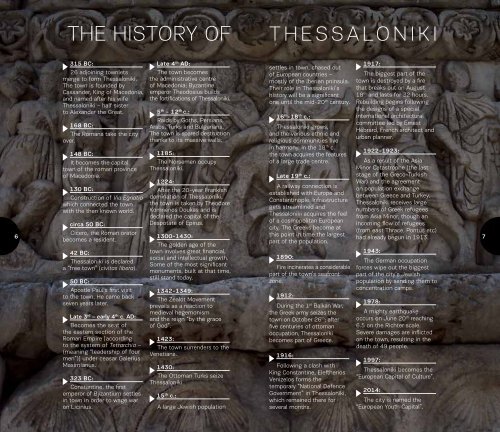Thessaloniki_EN
You also want an ePaper? Increase the reach of your titles
YUMPU automatically turns print PDFs into web optimized ePapers that Google loves.
THE HISTORY OF<br />
THESSALONIKI<br />
6<br />
315 BC:<br />
26 adjoining townlets<br />
merge to form <strong>Thessaloniki</strong>.<br />
The town is founded by<br />
Cassander, King of Macedonia,<br />
and named after his wife<br />
<strong>Thessaloniki</strong> – half sister<br />
to Alexander the Great.<br />
168 BC:<br />
The Romans take the city<br />
over.<br />
148 BC:<br />
It becomes the capital<br />
town of the roman province<br />
of Macedonia.<br />
130 BC:<br />
Construction of Via Egnatia<br />
which connected the town<br />
with the then known world.<br />
circa 50 BC:<br />
Cicero, the Roman orator<br />
becomes a resident.<br />
42 BC:<br />
<strong>Thessaloniki</strong> is declared<br />
a “free town” (civitas libera).<br />
50 BC:<br />
Apostle Paul’s first visit<br />
to the town. He came back<br />
seven years later.<br />
Late 3 rd – early 4 th c. AD:<br />
Becomes the seat of<br />
the eastern section of the<br />
Roman Empire [according<br />
to the system of Tetrarchia –<br />
(meaning “leadership of four<br />
men”)] under ceasar Galerius<br />
Maximianus.<br />
323 BC:<br />
Constantine, the first<br />
emperor of Byzantium settles<br />
in town in order to wage war<br />
on Licinius.<br />
Late 4 th AD:<br />
The town becomes<br />
the administrative centre<br />
of Macedonia; Byzantine<br />
emperor Theodosius builds<br />
the fortifications of <strong>Thessaloniki</strong>.<br />
5 th - 12 th c.:<br />
Raids by Goths, Persians,<br />
Arabs, Turks and Bulgarians.<br />
The town is spared destruction<br />
thanks to its massive walls.<br />
1185:<br />
The Norsemen occupy<br />
<strong>Thessaloniki</strong>.<br />
1224:<br />
After the 20-year Frankish<br />
domination of <strong>Thessaloniki</strong>,<br />
the town is taken by Theodore<br />
Komnenos Doukas and is<br />
declared the capital of the<br />
Despotate of Epirus.<br />
1300-1430:<br />
The golden age of the<br />
town involves great financial,<br />
social and intellectual growth.<br />
Some of the most significant<br />
monuments, built at that time,<br />
still stand today.<br />
1342-1349:<br />
The Zealot Movement<br />
prevails as a reaction to<br />
medieval hegemonism<br />
and the reign “by the grace<br />
of God”.<br />
1423:<br />
The town surrenders to the<br />
Venetians.<br />
1430:<br />
The Ottoman Turks seize<br />
<strong>Thessaloniki</strong>.<br />
15 th c.:<br />
A large Jewish population<br />
settles in town, chased out<br />
of European countries –<br />
mostly of the Iberian pninsula.<br />
Their role in <strong>Thessaloniki</strong>’s<br />
history will be a significant<br />
one until the mid-20 th century.<br />
16 th -18 th c.:<br />
<strong>Thessaloniki</strong> grows,<br />
and the various ethnic and<br />
religious communities live<br />
in harmony. In the 18 th c.<br />
the town acquires the features<br />
of a large trade centre.<br />
Late 19 th c.:<br />
A railway connection is<br />
established with Europe and<br />
Constantinople. Infrastructure<br />
gets streamlined and<br />
<strong>Thessaloniki</strong> acquires the feel<br />
of a cosmopolitan European<br />
city. The Greeks become at<br />
this point in time the largest<br />
part of the population.<br />
1890:<br />
Fire incinerates a considerable<br />
part of the town’s seafront<br />
zone.<br />
1912:<br />
During the 1 st Balkan War,<br />
the Greek army seizes the<br />
town on October 26 th ; after<br />
five centuries of ottoman<br />
occupation, <strong>Thessaloniki</strong><br />
becomes part of Greece.<br />
1916:<br />
Following a clash with<br />
King Constantine, Eleftherios<br />
Venizelos forms the<br />
temporary “National Defence<br />
Government” in <strong>Thessaloniki</strong>,<br />
which remained there for<br />
several months.<br />
1917:<br />
The biggest part of the<br />
town is destroyed by a fire<br />
that breaks out on August<br />
18 th and lasts for 32 hours.<br />
Rebuilding begins following<br />
the designs of a special<br />
international architectural<br />
committee led by Ernest<br />
Hébrard, French architect and<br />
urban planner.<br />
1922-1923:<br />
As a result of the Asia<br />
Minor Catastrophe (the last<br />
stage of the Greco-Turkish<br />
War) and the agreement<br />
on population exchange<br />
between Greece and Turkey,<br />
<strong>Thessaloniki</strong> receives large<br />
numbers of Greek refugees<br />
from Asia Minor, though an<br />
incoming flow of refugees<br />
(from east Thrace, Pontus etc)<br />
had already begun in 1913.<br />
1943:<br />
The German occupation<br />
forces wipe out the biggest<br />
part of the city’s Jewish<br />
population by sending them to<br />
concentration camps.<br />
1978:<br />
A mighty earthquake<br />
occurs on June 20 th reaching<br />
6.5 on the Richter scale.<br />
Severe damages are inflicted<br />
on the town, resulting in the<br />
death of 49 people.<br />
1997:<br />
<strong>Thessaloniki</strong> becomes the<br />
“European Capital of Culture”.<br />
2014:<br />
The city is named the<br />
“European Youth Capital”.<br />
7


